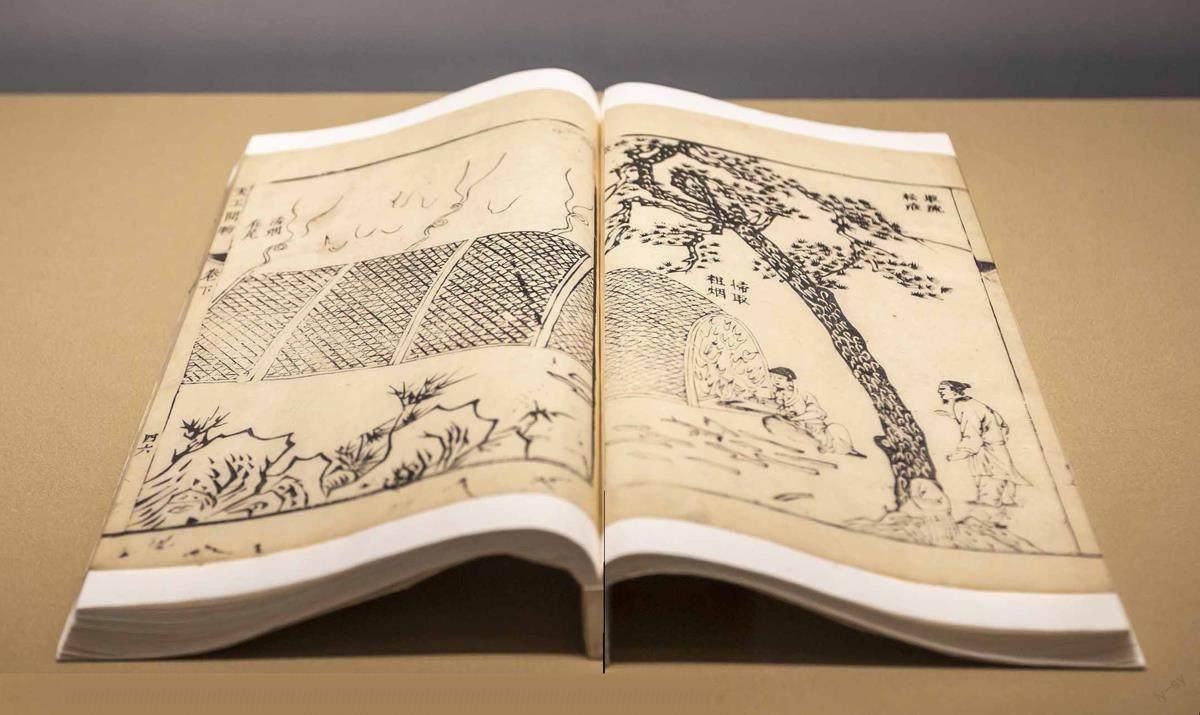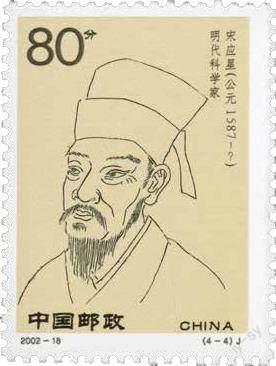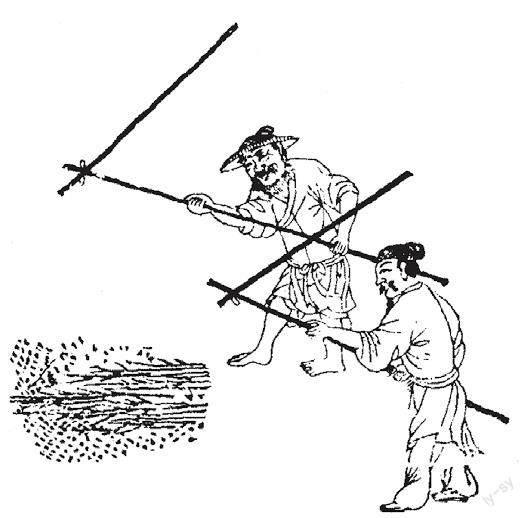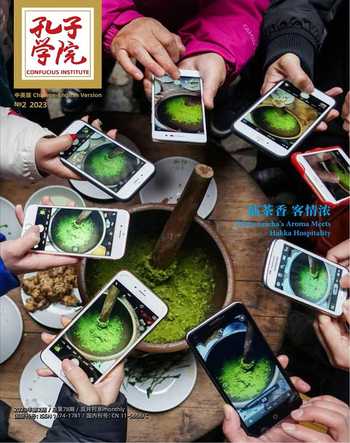宋应星与《天工开物》Song Yingxing and His Masterpiece Tiangong Kaiwu
崔高浩



2020 年底,中国嫦娥五号月球无人探测器采集到了月壤样品并成功返回地球。2021 年,国际天文学联合会(IAU) 正式批准了嫦娥五号着陆点附近八个月球地貌的命名,这八个命名中有许多中国古代科学家的名字,其中就有被英国著名生物化学家(曾因研究中國科学史而声名远扬的)李约瑟(JosephNeedham,1900—1995)誉为“中国狄德罗(Diderot)”的宋应星,他的作品《天工开物》被称为“中国17 世纪的工艺百科全书”。
At the end of 2020, Chinas Change-5 lunar probecollected lunar soil samples and successfully returnedto Earth. In 2021, the International AstronomicalUnion (IAU) officially approved the naming of eightlunar landforms near the landing site of Change-5,among which were names of ancient Chinese scientists,including Song Yingxing, addressed as “the ChineseDiderot” by the renowned British biochemist andhistorian Joseph Needham1 (1900–1995) for his workTiangong Kaiwu, known as the “Chinas Encyclopediaof Crafts in the 17th Century”.
宋应星其人Introduction to Song Yingxing
宋应星(1587— 约1666) 是明朝科学家,出生于中国江西南昌府奉新县的一个士大夫家庭,在四兄弟中排行第三。他从小就聪明过人,过目不忘,记忆力惊人。1615 年(明万历四十三年),宋应星和兄长宋应升一起通过乡试中举。此后虽几经会试,但均告失败,两兄弟遂绝科举之念。1635 年(崇祯八年),宋应星任县学教谕。1643 年(崇祯十六年),又任亳(Bó) 州知州。但第二年初,他便辞官返乡。当时,大明王朝气数已尽。当年三月,李自成大军攻破京师,明朝灭亡。1646 年(隆武二年),宋应升服毒殉国,宋应星开始了隐居生活,拒不出仕。虽然具体卒年尚不清楚,但据推测,宋应星大约在1661 年或1666 年逝世。
Song Yingxing (1587–ca.1666) was a Ming Dynasty scientist who wasborn into a scholar-official family in Fengxin County of Nanchang Prefecturein Jiangxi Province. He was the third of four sons and had an exceptionalmemory and intelligence since a young age. In 1615 (the 43rd year of theWanli reign of the Ming Dynasty), Song Yingxing and his elder brother, SongYingsheng, passed the provincial-level imperial examinations. However, sincetheir later attempts to pass the higher level of examinations had all failed in theend, the two brothers felt frustrated and abandoned their hopes of pursuing acareer as a government official through the imperial examination system. In1635 (the 8th year of the Chongzhen reign), Song Yingxing became a teacherat a county school, and in 1643 (the 16th year of the Chongzhen reign), hewas appointed as the magistrate of Bozhou Prefecture. But he quickly resignedand returned home early the next year when the fate of the Ming Dynasty wasalready sealed. In March of the same year, Li Zichengs rebel army capturedthe capital Beijing, and the Ming Dynasty collapsed. In 1646 (the second yearof the Longwu reign), his elder brother Song Yingsheng committed suicide forthe fallen Ming Empire by taking poison, and he began a life of seclusion andrefused to accept any official position in the new government. Although theexact year of his death is not known, it is estimated that Song Yingxing diedaround 1661 or 1666.
《天工开物》的创作背景The Historical Background of Tiangong Kaiwu
《天工开物》中的“天工”取自《尚书·皋陶谟》的“天工人其代之” ,“开物”取自《周易·系辞上》的“开物成务”。“天工”与“人工”相对,指自然的事物;“开物”则指人类通过工具和技术造物。因此,“天工开物”意为人类通过主观努力,利用自然资源造物。
The term tiangong in the book title comes fromthe article “Gaoyao Mo” from one of the Five ClassicShangshu (The Book of Documents) while kaiwu istaken from another ancient text “Xici” in Zhouyi (TheBook of Changes). Tiangong, the opposite of rengong(literally meaning works of human), means works ofnature; kaiwu refers to human creation using toolsand technology. Therefore, tiangong kaiwu means thathuman beings create things by making use of naturalresources.
在《天工开物》问世的明朝,许多产业都比较发达,城市繁荣,商品经济活跃,市井文化如雨后春笋般兴起。此外,重视“知行合一”的心学广泛流行,西洋传教士将西方文化产物介绍到中国,这些都有助于植物学、农学、地理学等实用的技术科学著作的发展,李时珍的《本草纲目》、徐光启的《农政全书》以及宋应星的《天工开物》就是在这样的背景下创作出来的。
In the Ming Dynasty when this book was published,with many industries relatively developed,cities were prosperous, and the commodity economyactive. Therefore, popular culture in the urban areawas booming. In addition, the widespread of thephilosophy of the mind which emphasized the “unityof knowledge and action” and the introduction ofWestern cultural products by Western missionaries toChina contributed to the development of technical andscientific works on botany, agriculture, geography, andother practical fields. For example, Li Shizhens BencaoGangmu (The Compendium of Materia Medica), XuGuangqis Nongzheng Quanshu (The Complete Book onAgriculture) and Song Yingxings Tiangong Kaiwu (TheExploitation of the Works of Nature) were all created inthis context.
《天工開物》的内容Introduction to Tiangong Kaiwu
《天工开物》共三篇十八卷。
The book is divided into three volumes, with a total of eighteen chapters.
上篇涉及天产:乃粒(粮食作物的栽培技术)、乃服(衣服原料的来源及加工方法)、彰施(植物染料的染色方法)、粹精(谷物的加工过程)、作咸(六种食盐的生产方法)、甘嗜(种植甘蔗及制糖、养蜂的方法)。
The first volume discusses techniques of processing natural products, including naili (cultivation techniques for grains and other food crops), naifu(processing of raw materials for clothing), zhangshi(plant-based dyeing techniques), cuijing (processing of grains), zuoxian (salt production in six ways), and ganshi (sugarcane cultivation, sugar-making, and beekeeping).
中篇涉及人工制造:陶埏(shān)(砖、瓦、陶瓷的制作)、冶铸(金属用品的铸造及加工)、舟车(船舶、车辆的结构、型式及制作)、锤(chuí)锻(用锤锻方法制作铁器和铜器)、燔石(石灰、煤炭等的烧制技术)、膏液(16 种植物油脂的提取方法)、杀青(造纸的五个程序)。
The second volume focuses on human-madeproducts, such as taoshan (production of brick, tile, andceramic objects), yezhu (metal casting and forging),zhouche (structure, style and construction of shipsand vehicles), chuiduan (forging of iron and copperby hammering), fanshi (firing techniques of lime, coal,etc.), gaoye (16 oil and fat extraction methods), andshaqing (five procedures of papermaking).
下篇讲述了与物品功用相关的内容:五金(金属的开采和冶炼)、佳兵(弓、弩、盾等冷兵器以及火药等武器的制造方法)、丹青(墨和颜料的制作)、曲蘖(niè)(制酒的方法)、珠玉(宝石的来源)。
The third volume is concerned withitems and their functions, includingwujin (metalworking and metallurgy),jiabing (production of gunpowder andcold weapons such as bows, crossbowsand shields), danqing (ink and pigmentproduction), qunie (liquor making),and zhuyu (jewelry sourcing).
从结构上可见,《天工开物》是一部囊括了当时主要产业的“百科全书”。宋应星以观察、经验和实证为基础,具体阐释了多种产业的生产过程,并配了123 幅插图。这些插图形象具体,详细地描述了各种制造技术和过程。另外,《天工开物》里没有记载方书和本草学的相关内容,这表明宋应星是一位以客观、实证的姿态试图对物质世界进行独创性探索和认识的伟大学者。
The structure of the book shows that itis an all-encompassing encyclopedia of themajor industries of the time. Song Yingxingbased his work on observation, experience, andexperimentation, providing detailed explanations ofvarious production processes, accompanied by 123illustrations that vividly and specifically describethe procedures. The book does not cover topicsrelated to traditional Chinese medicine orpharmacology, but this reveals Songs objective,prudent, and down-to-earth approach toexploring and understanding the world.
《天工開物》的传播The Spread of Tiangong Kaiwu
1637 年(崇祯十年),在宋应星的友人涂绍煃(kuǐ)的资助下,《天工开物》首次在南昌府刊行。清初的杨素卿翻刻此本,此本流通范围较广。此后,《天工开物》被收录在《古今图书集成》和《授时通考》中,后在中国渐被遗忘,事实上已失传很久。17 世纪,《天工开物》被传到了当时江户时代的日本,并被制作了很多副本。1771 年,大阪的书林菅( jiān)生堂出版了和刻本,此后几经再版并越发受到重视。直到民国时期,在日本留学的中国人将《天工开物》和刻本带回中国,《天工开物》的存在和价值才重新被发现。
In 1637 (the 10th year of the Chongzhen reign),subsidized by his friend Tu Shaokui, Song Yingxingpublished his work Tiangong Kaiwu for the first timein Nanchang Prefecture. Yang Suqing of the earlyQing Dynasty later published a new edition of thebook, which was more widely circulated. After that,the book was included in Gujin Tushu Jicheng (TheComplete Collection of Illustrations and Writings fromthe Earliest to Current Times) and Shoushi Tongkao (a comprehensive handbook on agriculture by QingDynasty officials). However, it gradually becameforgotten in China and was considered lost for along time. Fortunately, it was introduced to Japanduring the Edo period in the 17th century, and manycopies were made. In 1771, a xylographic editionwas published by the Shurindo bookstore in Osaka,and it was subsequently reprinted and gained moreattention. It wasnt until the period of the Republic ofChina(1912–1949) that Chinese scholars studying inJapan brought back copies of Tiangong Kaiwu to China,leading to a rediscovery of its value and existence.
此外,《天工开物》在18 世纪以后传入朝鲜,在朴趾源的《热河日记》和徐有榘( jǔ) 的《林园经济志》等书中均被提及。
In addition, Tiangong Kaiwu was introduced toKorea after the 18th century and was mentioned in someChinese books by Korean scholars such as Park Ji-wonsRehe Riji (Rehe Diary) and Seo Yu-gus Linyuan Jingji Zhi.
宋應星纪念馆The Song Yingxing Memorial Hall
就像月球上的一处地貌以宋应星的名字命名一样,江西南昌市奉新县也被称为“宋应星县”。奉新县大力歌颂宋应星的丰功伟绩,诸如应星北大道、应星南大道等中心街道名以及宋应星公园、宋应星纪念馆等地名都体现了这一点。
Like one of the lunar landforms, Fengxin Countyin Nanchang City, Jiangxi Province is also named afterthis great scientist and is now known as “Song YingxingCounty” to honor Songs remarkable achievements,many roads and places are named after him, includingNorth and South Yingxing Avenues, Song YingxingPark, and Song Yingxing Memorial Hall.
宋应星纪念馆位于宋应星公园内,由主馆、天工馆和开物馆组成,系统详实地介绍了宋应星及《天工开物》的相关资料和内容。特别是天工馆和开物馆都使用了尖端科学技术,生动形象地展示了农业和手工业的制作过程,对江西省乃至全中国的科学普及和科学教育都发挥了重要作用。
The memorial is located in Song Yingxing Park.With three major halls — Main Hall, TiangongHall, and Kaiwu Hall, it offers visitors a systemicintroduction of the scientist and his work, TiangongKaiwu. In particular, in Tiangong Hall and KaiwuHall, advanced technologies are employed to providevivid demonstrations of the production process inagriculture and handicraft industries in ancient China.The memorial plays an important role in spreadingscientific knowledge and educating the public inJiangxi Province and beyond.
- 孔子学院的其它文章
- 二十四节气Twenty-four Solar Terms
- 二十四节气之惊蛰和春分Twenty-four Solar Terms
- 滕王阁, 因王勃而不朽Wang Bo’s Literary Genius Elevates the Pavilion of Prince Teng to Fame
- 不识庐山真面目Of Mountain Lu We Cannot Make Out the True Face
- 如何介绍南昌Teaching: Introducing Nanchang to International Students
- 汉语的教与学Teaching and Learning Chinese

